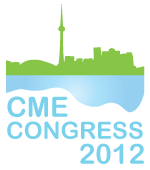Leila Lax (Assistant Professor, Biomedical Communications, Institute of Medical Science, Faculty of Medicine, University of Toronto & University of Toronto Mississauga)
Synopsis
This study investigates the potential of Knowledge Building, a collaborative and participatory design paradigm for CME. Results demonstrated strong relationships between knowledge improvement pre/post-test outcomes and social network measures of high build-on note density, low cohesion index, low Eigenvector centrality, accompanied by significant measures of centrality, confirming Knowledge Building principles and the importance of distributed networks, decentralized participation, and democratization of ideas in a communal space.
Purpose
This study investigates the potential of Knowledge Building, a collaborative and participatory design paradigm for CME. Knowledge Building is a fundamentally social process requiring creation and continual improvement of ideas, with members sharing responsibility for advancing not just individual, but group knowledge. This is considered design-mode knowledge work. Much of current CME operates in belief-mode, by knowledge transmission. This research study examines design-mode and belief-mode Knowledge Building in the End-of-Life Care Distance Education Program.
Methods
Pedagogic design of the problem space was both structured and unstructured, case-based with learning objectives and open to participant identified needs — to enable participants to take charge of knowledge advancement at high cognitive levels.
A case study methodology was used. Traditional belief-mode evaluation measures including pre-/post-test results, effect size, and opinion surveys were combined with design-mode measures of online activity and social network assessments.
Results
Results demonstrated strong relationships between knowledge improvement pre/post-test outcomes and social network measures of high build-on note density, low cohesion index, low Eigenvector centrality, accompanied by significant measures of centrality, confirming Knowledge Building principles and the importance of distributed networks, decentralized participation, and democratization of ideas in a communal space.
Applications
Designs appropriate for CME are shown to facilitate a shift from learning as an exclusively individual enterprise with external assessment driven by pre-determined objectives to the creation of a Knowledge Building Community with participants assuming responsibility and agency normally assumed by the instructor, for emergence of relevant issues, and authentic, meaningful problems — integral to knowledge improvement.
Declaration
No real or apparent conflict(s) of interest.
The Development of a Qualitative
Meta-ethnography Web-based Tool
Ross Barclay (University of Toronto); Mary Bell (University of Toronto); Susan Rock (University of Toronto)
Purpose
To build a web based tool to coordinate a peer review qualitative system.
Method
Based on an already established web based peer review process, discussions occurred about the adaptation to a web based meta-ethnography tool to review and screen abstracts, retrieve relevant articles, independently score for relevance, and assess for quality. Using this meta-ethnography tool, key analytical metaphors within each study were identified to determine a conceptual model across papers.
Because of the specific requirements of the ethnography process, the proposed system needed to allow and cue for the collection of in excess of 60 qualitative data concepts from multiple articles while allowing for full-text viewing and copying from the articles. The system needed to be easy to use and intuitive for the approximately 10 reviewers who were using a system of novel design for which existing workflows did not exist. The system needed to work on a variety of screen sizes and types (laptops, desktop computers) and allow for the rich display of journal articles including all tables and layout.
To allow for effective and comprehensive analysis of the large amount of qualitative data, a grid-style reporting system was implemented. These grids allowed for the analysis of concepts identified across papers and across reviewers.
Results
This tool is a practical and reliable method for synthesizing reviewer feedback. For example this tool was used to assess 21,489 abstracts across six chronic diseases (cancer, HIV, CVD, asthma, arthritis, diabetes). 1,412 abstracts were selected for full-length review. 58 articles were subjected to quality assessment, of which 25 were included in the meta-ethnography.
Applications
This meta-ethnography tool is a model that is transferable to other healthcare or continuing
education research.
Future Directions
This tool will be expanded further to be considered as a potential qualitative research product. It will be possible to allow independent researchers to create projects consisting of articles and reviewers, and to allow them to manage their projects and to follow the review process in real-time using the tool.
Declaration
The authors have no relevant conflicts of interest to declare.





